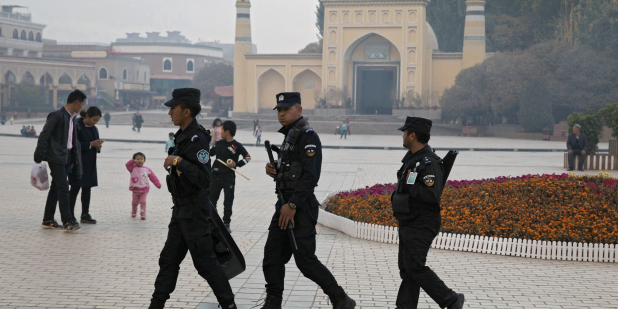Join us for a free one-day workshop for educators at the Japanese American National Museum, hosted by the USC U.S.-China Institute and the National Consortium for Teaching about Asia. This workshop will include a guided tour of the beloved exhibition Common Ground: The Heart of Community, slated to close permanently in January 2025. Following the tour, learn strategies for engaging students in the primary source artifacts, images, and documents found in JANM’s vast collection and discover classroom-ready resources to support teaching and learning about the Japanese American experience.
What's At Stake In Xinjiang
A symposium featuring a distinguished panel of specialists to discuss Uyghur beliefs and Chinese government policies in the region.

On May 9, 2020, we hosted a symposium on what is happening in Xinjiang and why it matters. Dru Gladney of Pomona College reviewed the history of China’s policies toward ethnic minorities and the region’s economic and strategic importance. Nurnisa Kurban of UyghurLA shared her experiences growing up in Kashgar and attending Xinjiang University and describing the very real human cost of the party-state’s increasingly tight controls in the region. Ethnomusicologist Elise Anderson drew on her years of research in Xinjiang to detail the assault on Uyghur culture, highlighting the example of the Muqam. In addition to their presentations, each of these scholars responded to a variety of questions including on what’s driving these policies and the impact they are having on families and individuals. Are the policies counterproductive? How has the migration of Han Chinese to the region changed it? Won’t economic development erase the tensions in the region? Is Are Americans and other Westerners concerned about Xinjiang only because of the negative light it shines on China? These questions and more were discussed.
The discussion attracted a huge audience live. Some of those participating are well-known figures (a former Indian ambassador, scholars, and activists). Many were educators in schools. The event was part of our workshop series offered in conjunction with the National Consortium for Teaching about Asia, funded by the Freeman Foundation.
Some background:
The Xinjiang Uyghur Autonomous Region in China’s northwest is enormous, including about one-sixth of China’s total land area. It is sparsely populated, with just 24 million people (38 people/square mile) and includes sweeping deserts and beautiful mountains. The region is vital to China’s economy, with the largest share of the country’s coal, natural gas and oil reserves. It is strategically important, sharing a border with eight countries. Xi Jinping’s Belt and Road Initiative aims to tie China closer to Xinjiang’s neighbors and develop the region.
As big as Alaska and having more people than Florida, Xinjiang today looms larger in the consciousness of for Americans than ever before. For three years, they have gradually learned about the systematic extrajudicial detention of a million people, perhaps one-tenth of the region’s Uyghur population. It’s one of the reasons (along with concerns over the environment, cybersecurity, and trade) that led two out of three Americans in March to tell Pew Research Center pollsters they had an unfavorable impression of China. This is the most negative Americans have been towards China since Pew began asking in 2005. 82% of Americans told Pew that they saw China’s human rights policies as serious problems. A Gallup Organization survey in February yielded the same results.
China’s government describes the camps as providing vocational and language training to equip Uyghurs and other Muslim detainees with skills to improve their job prospects. It has organized visits for some journalists to camps and interviews with some individuals about their experiences there. Interviewees told NPR they were brought to the camp because they had “extremist thoughts,” involved children in religious activities, or kept women from working. One said he had al-Qaida videos on his phone. All said that before their detention they didn’t realize the authorities considered these ideas or actions extremist or illegal. Detention and indoctrination are intended to prevent action. There are no formal charges, trials, fixed sentences or processes for appeal. Detainees do not know if, let alone when, they may be released.
China’s Communist Party took control of Xinjiang in 1949. It has always been under central administration, with a large military presence. Restrictions on everyday life, however, are tighter today than in the past. In part, it reflects a greater emphasis on security throughout China, but it’s become particularly acute in Xinjiang following a crackdown ordered in 2014. That followed a violent attack by a handful of Uyghurs outside of Xinjiang. Even before these large scale extrajudicial detentions, formal criminal arrests in Xinjiang rose from 14,000 in 2013 to 228,000 in 2017.
Although living standards have improved significantly, all agree that Xinjiang needs development. Like other parts of western China, people in Xinjiang have, on average, lower incomes and live shorter lives than those elsewhere in China.
Uyghurs and other ethnic minorities say opportunities with the state companies building infrastructure or exploiting mineral resources go disproportionately to Han Chinese (over 90% of China’s citizens are categorized as Han). Uyghurs say that Han entrepreneurs enjoy better access to capital and networks. In 1945, perhaps 6% of Xinjiang’s population was Han, rising to 40% at the start of 1980s. It may be slightly lower now and most migrants move on their own rather than in accordance with state directives, but Han dominate Urumqi and other northern Xinjiang employment centers while poorer and rural southern Xinjiang is predominantly Uyghur. China’s government has put $70 billion into Belt and Road Initiative investments in Xinjiang. The Asian Development Bank is assisting. This should strengthen trade with Central Asia.
China’s government argues its security and development campaigns mitigate religious extremism and separatist threats. Critics contend the policies violate China’s own laws and international prohibitions against arbitrary detention. They say detention and other policies work to eradicate distinctive and cherished aspects of Uyghur life and culture.
 Elise Anderson - Sr. Program Officer for Research & Advocacy, Uyghur Human Rights Project
Elise Anderson - Sr. Program Officer for Research & Advocacy, Uyghur Human Rights Project"Cultural Destruction in Xinjiang"

Dru Gladney - Professor & Chair of Anthropology, Pomona College
"China's Xinjiang Problem: How did we get here?"
Dru Gladney specializes in the peoples, cultures and politics along the ancient and modern Silk Road—in particular, issues of globalization and transnationalism in China and its close neighbors. Over the last few years, he has engaged in a large comparative survey of nomadic families in Western China, bolstered by in-depth fieldwork with nomadic Kazakhs in the Altai Mountains bordering China and Mongolia.

"Cultural Genocide in Xinjiang"
Featured Articles
Please join us for the Grad Mixer! Hosted by USC Annenberg Office of International Affairs, Enjoy food, drink and conversation with fellow students across USC Annenberg. Graduate students from any field are welcome to join, so it is a great opportunity to meet fellow students with IR/foreign policy-related research topics and interests.
RSVP link: https://forms.gle/1zer188RE9dCS6Ho6
Events
Hosted by USC Annenberg Office of International Affairs, enjoy food, drink and conversation with fellow international students.
Join us for an in-person conversation on Thursday, November 7th at 4pm with author David M. Lampton as he discusses his new book, Living U.S.-China Relations: From Cold War to Cold War. The book examines the history of U.S.-China relations across eight U.S. presidential administrations.




